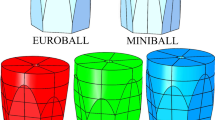Abstract
Ge(Li) detectors, which are very high resolution γ-ray spectrometers, are extremely sensitive to defects in the junction of the detector. These defects act as charge-trapping centers and seriously degrade the detector performance. Several techniques, which include the detector monochromatic infrared response, reverse current characteristics, and performance analysis, have been used to study these defects. The results indicate that degradation of the detector spectrum is due both to detector inhomogeneities and traps. The main inhomogeneity is caused by a localized variation in the precipitation rate of lithium, which results in weak detector collection fields and heavier localized trapping. The properties of copper, nickel, and iron as traps indicate that the presence of lithium modifies the trap behavior by shielding the Coulomb force and by shifting the deep-trap energy states. The most important traps are those due to lithium effects. The precipitate phase of lithium behaves as a hole trap with a distributed energy level system. A separate lithium phase involving the complex formation of lithium with thermal defects results in an electron trap with an energy position located atE c−Et=0.22 ev.
Similar content being viewed by others
References
R. B. Day, G. Dearnaley, and J. M. Palms:IEEE Trans. Nucl. Sci., 1967, vol. NS-14, p. 487.
E. Sakai, H. L. Malm, and I. L. Fowler: Atomic Energy of Canada Ltd Rept AECL-2762, Chalk River, Ontario, 1967.
R. Tramwell and F. J. Walter:Nucl. Inst. and Methods, 1969, vol. 76, p. 317.
E. J. Rivet: Lawrence Radiation Laboratory, Livermore, Report UCRL-18403, Berkeley, Calif.
H. Ueda:J. Phys. Soc. Japan, 1961, vol. 16, p. 61.
R. D. Weltzin, R. A. Swalin, and T. E. Hutchinson:Acta Met., 1965, vol. 13, p. 115.
R. D. Weltzin and R. A. Swalin: Fourth Technical Report, Contract Nonr 710(27), University of Minnesota Department of Metallurgy, July 20, 1962.
M. G. Chartrand and H. L. Malm: Atomic Energy of Canada Ltd Rept AECL-2764, Chalk River, Ontario, June, 1967.
W. Hansen: Lawrence Radiation Laboratory, Berkeley, Calif., private communication, July, 1969.
S. M. Sze and J. C. Irvin:Solid-State Electronics, 1968, vol. 11, p. 599.
F. J. Morin and H. Reiss:Phys. Rev., 1957, vol. 105, p. 384.
V. V. Ostroborodova and S. V. Ivanova:Soviet Phys.-Solid-State, 1965, vol. 7, p. 1525.
P. G. El’seev and S. G. Kalashnikov:Soveit Phys.-Solid-State, 1963, vol. 5, p. 233.
M. Cherki and A. H. Kalma:Solid-State Communications, 1969, vol. 7, p. 15.
R. C. Young, J. W. Westhead, and J. C. Corelli:J. Appl. Phys., 1969, vol. 40, p. 271.
Author information
Authors and Affiliations
Rights and permissions
About this article
Cite this article
Armantrout, G.A. Defect study and identification in Ge(Li) P-N junction radiation detectors. Metall Trans 1, 659–665 (1970). https://doi.org/10.1007/BF02811593
Issue Date:
DOI: https://doi.org/10.1007/BF02811593




